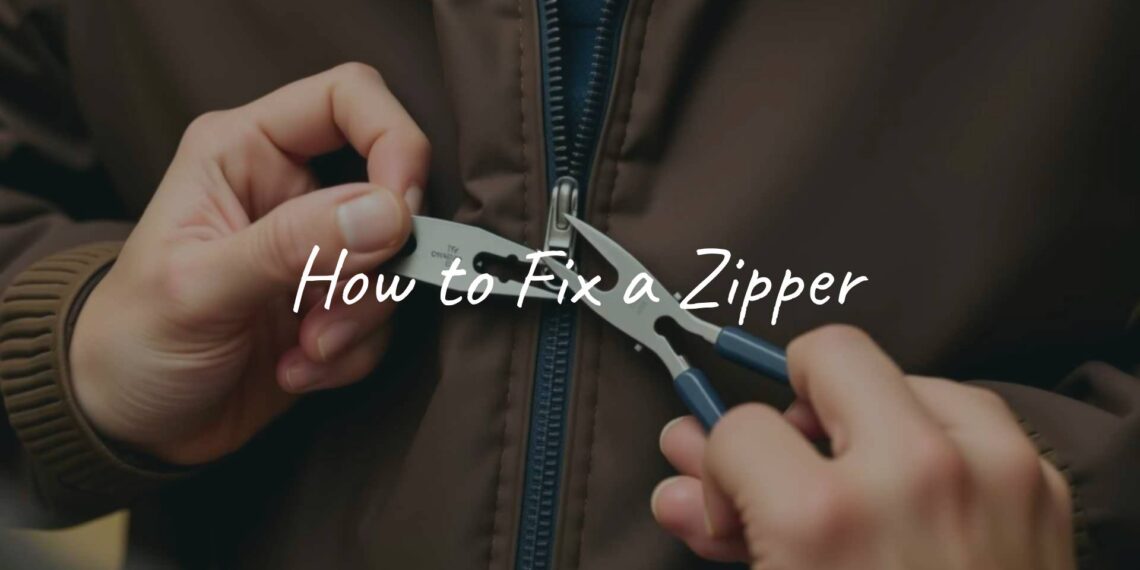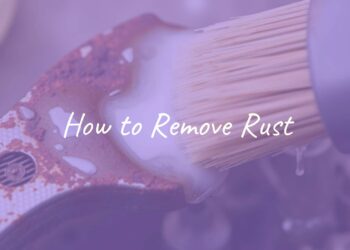Staring at a zipper that won’t move, splits open, or slides down by itself? You can often fix it at home. A quick repair can save your favorite jacket, bag, or jeans, cut costs, and keep items in use longer. With basic tools, a little patience, and clear steps, most zipper issues are easy to handle. This guide shows simple ways to fix common problems so you can get your gear working again.
What are common zipper problems?
Zippers do a simple job well, but they can fail in a few common ways. Knowing what went wrong helps you pick the right fix.
Zipper gets stuck or jammed
Fabric, threads, or lint can get caught in the teeth or slider and stop movement. Dirt or sticky buildup can also create friction. Forcing a stuck zipper can bend teeth or damage the slider, so stop and check what’s blocking it.
Teeth misalign or separate
If the zipper seems to close but then opens right away, the slider may be worn and too wide to press the teeth together. Bent teeth can also stop the parts from locking as they should.
Slider comes off the track
Sometimes the slider pops off one or both sides of the track, often because the top stop came loose or fell off. This looks bad, but you can often put it back on without replacing the full zipper.
Zipper won’t stay up
If the slider keeps sliding down, the teeth or slider may be worn. A loose slider can’t grip the teeth well enough to hold the zipper closed.
Missing or broken teeth
A few damaged teeth can sometimes be worked around, but large gaps or many missing teeth usually mean the zipper won’t hold. In that case, a full replacement is the most reliable fix.
Zipper pull breaks or comes off
When the pull tab snaps off, the zipper still works but is hard to use. This is an easy fix: swap the pull or use a quick stand-in.

What tools and materials do you need to fix a zipper?
Before you start, gather a few basic items. You likely already have many of them at home.
| Tool/Material | Main use |
|---|---|
| Pliers (needle-nose) | Tighten slider, adjust teeth, remove/add stops |
| Tweezers | Pull out caught threads or fabric |
| Needle and heavy thread | Sew new top/bottom stops, secure fabric |
| Replacement slider or pull | Swap damaged parts |
| Lubricant | Free stuck zippers (graphite, soap, etc.) |
| Scissors | Trim threads and frays |
| Small flathead screwdriver | Guide teeth into slider, lift stubborn stops |
| Safety pin or paper clip | Quick temporary fixes |

Pliers
Needle-nose pliers are the main tool you’ll use. They grip small parts well, helping you tighten a loose slider, straighten teeth, and crimp metal stops. Squeeze lightly to avoid crushing parts.
Tweezers
Use tweezers to grab tiny threads or fabric stuck in the teeth. They’re also helpful for small adjustments.
Needle and thread
Heavy-duty thread works best. Use it to sew new top stops if the old ones are gone, or to secure loose fabric around the zipper.
Replacement zipper slider or pull
If the slider is worn or broken, replace it with the same size. You can buy sliders or salvage one from another item. Repair kits often include a few sizes.
Lubricant (graphite pencil or bar soap)
For metal zippers, rub a No. 2 pencil on the teeth to add dry graphite. A bar of soap also helps. For plastic zippers, try a tiny bit of petroleum jelly or dish soap applied with a cotton swab. Wipe away extra so it doesn’t collect dirt. For outdoor gear, use a zipper-specific lube instead of oily products.
Scissors
Snip loose threads that cause jams and cut thread while sewing stops. If you must cut stuck fabric, go slowly and carefully.
Small screwdriver
A flathead screwdriver can help guide teeth into the slider or lift a stubborn metal stop.
Safety pin or paper clip (for temporary fixes)
Use these as a quick pull tab or hook a sliding zipper to a button to keep it up until you can do a proper repair.
Quick fixes for zipper emergencies
Need help right away? Try these fast tricks to get by for the moment.
Attach a paper clip or safety pin as a zipper pull
Clip a paper clip or safety pin through the hole in the slider to make a new pull. If the zipper won’t stay up, hook the clip or pin to the button to hold it in place for now.
Seal missing teeth areas with needle and thread
If a few teeth are missing near the bottom, move the slider above the gap and sew a new stop just above it. This shortens the zipper but lets it work. For small gaps in the middle, tight stitches across the gap may let the slider pass. This is only a short-term fix.
Use household items like bar soap or pencil to free a stuck zipper
Rub graphite from a No. 2 pencil or a bar of soap along the teeth near the stuck spot. For plastic teeth, try a tiny bit of petroleum jelly or a drop of dish soap with a cotton swab. Gently wiggle the slider without yanking. Wipe off extra lube when you’re done.
How to fix a stuck or jammed zipper
Don’t force it. Slow, careful steps usually solve the problem.
Identify the cause of the jam
Look closely for fabric, thread, or lint caught in the slider or between teeth. If you don’t see anything, check for dirt or sticky buildup. Also look for bent teeth that block the path.
Remove fabric caught in the teeth
Gently pull the fabric away from the zipper, not the other way around. Use tweezers or needle-nose pliers to grab trapped threads. A slow wiggle of the slider while easing the fabric out can help. Trim frays so they don’t snag again.
Apply lubricant to loosen the slider
For metal teeth, rub a No. 2 pencil or a bar of soap along both sides. For plastic teeth, try a small amount of petroleum jelly or dish soap on a cotton swab. Work it into the teeth and slider. Avoid oily products on outdoor gear; use a zipper-safe lube instead.
Move the slider gently to free the zipper
Hold the slider body (not just the pull) and ease it up and down a little at a time. If it resists, add a bit more lube and try again. Once it moves, run it the full length a few times to spread the lubricant. Wipe off any extra to prevent stains.
How to repair a zipper that won’t close properly
If the zipper keeps splitting open, the slider usually needs attention.
Check for bent or misaligned teeth
Scan the whole zipper for teeth that look twisted or out of place. Gently straighten them with your fingers or needle-nose pliers so each tooth lines up with its match.
Realign zipper teeth
If a tooth is slightly bent, nudge it back carefully. Work slowly to avoid snapping it off. If several teeth are badly damaged and won’t line up, a full zipper replacement may be needed.
Tighten the zipper slider using pliers
A worn slider spreads open and loses grip. With needle-nose pliers, lightly pinch the top and bottom plates of the slider together to narrow the gap where the teeth pass. Make small adjustments and test often. Do not crush the slider.

Replace the zipper slider if necessary
If tightening doesn’t help or the slider is cracked or warped, replace it. Remove the top stop on the slider’s side with pliers, slide the old slider off, and note its orientation. Slide the new one on the same way. Reattach the metal stop or sew a thread stop if the original can’t be reused.
How to fix a separated or broken zipper
If the slider has come off or the zipper has split apart, you can often reset it with a few steps.
Remove the zipper stop or top stops
Use needle-nose pliers or end nippers to lift off the top stop on the side where you’ll reinstall the slider. Save a metal stop if you can reuse it. Plastic stops often break and will need a thread stop later. For two sliders, you may need to remove stops on both sides.
Reinstall or replace the zipper slider
If the old slider is still good, slide it off and re-thread it onto the teeth in the correct direction. If you’re swapping in a new slider, match the size and orientation. A small flathead screwdriver can help guide the teeth into place. Move the slider down a little to confirm both sides are engaged.

Reattach zipper stops securely
Crimp the saved metal stop back on with pliers so the slider can’t come off again. If you can’t reuse it, sew a new stop with heavy thread: make several tight stitches across the tape at the top edge and knot firmly.
Test zipper function to check your repair
Run the slider up and down a few times. Watch for sticking, splitting, or misalignment. If it feels tight, add a small amount of lube. If it still separates, tighten the slider a bit more or inspect the teeth for damage.
How to fix a zipper that won’t stay up
When the slider creeps down, you can often fix it in minutes.
Tighten the slider with pliers
Lightly pinch the slider plates together to reduce the gap and boost grip on the teeth. Make small tweaks and test often. Stop if the slider starts to bind; squeezing too hard can ruin it.
Use a keyring or rubber band as a temporary solution
Loop a small keyring or sturdy rubber band through the pull, then hook it over the button at the waistband. This holds the slider up until you can do a proper fix.
Apply clear nail polish to hold zipper in place
Worn teeth can be “built up” a bit with clear nail polish. Zip up, paint a thin coat on the top few teeth where slipping starts, let it dry, and test. Add another thin coat if needed, drying between coats so it doesn’t get tacky.
When should you replace a zipper?
Most problems can be fixed, but sometimes a new zipper is the better choice.
Multiple or missing teeth
If many teeth are gone or broken, the slider won’t have enough to grab. Repairs won’t hold well in this case. Replacing the whole zipper will give a reliable result.
Damaged zipper tape or fabric
If the zipper tape is torn or frayed, or the garment fabric around the zipper is ripped, the zipper won’t work right even with a new slider. You’ll need to replace the zipper, and the fabric may need sewing work too. This can call for stronger sewing skills or a tailor.
Ineffective temporary and permanent repairs
If you’ve tried lube, tightening, straightening teeth, and even a new slider, but it still fails, the zipper has likely worn out. Weigh the time and cost of replacement against how much you use and value the item.
How to prevent zipper problems in the future
A few quick habits can help your zippers last longer and avoid repeat repairs.
Clean and lubricate zippers regularly
Brush away dirt with a small brush, like an old toothbrush. For metal teeth, rub a graphite pencil on them now and then. For plastic teeth, use a silicone zipper lube or a tiny bit of petroleum jelly on a cotton swab. On technical gear, choose a zipper-specific lube that won’t attract grit.
Avoid forcing stuck zippers
Stop pulling the moment you feel resistance. Check for caught fabric or threads, clear them, add a little lube, and move the slider slowly. Never yank-this often causes breakage.
Check and repair minor issues early
Fix small snags before they grow:
- Tighten a slightly loose slider with a gentle pinch.
- Straighten a bent tooth.
- Trim fraying threads near the teeth.
Catching small problems early keeps the zipper working and extends the life of your clothes and gear.
















![What to with Scrap Metal? [infographic]?](https://facts-homes.com/wp-content/uploads/2019/07/645413-POPYOV-391-120x86.jpg)





